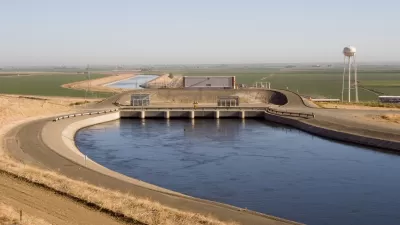At the height of the California drought, a group of water suppliers offered rebates for people willing to remove lawns. Now, it's time to figure out if the experiment worked.

Ellen Knickmeyer checks-in on a big expenditure in the state of California to remove lawns—call it a "cash-for-lawns" program.
After spending more than $350 million to remove lawns, the funds ran out in 2015, but now researchers are exploring whether the rebates worked. Using advanced tools like satellite images and infrared aerial photos, along with more old-fashioned tactics like driving through neighborhoods, the researchers are trying to calculate whether the cash-for-lawns had a lasting effect on the California landscape.
The program was initiated and funded by the Metropolitan Water District of Southern California, along with more than two dozen other participants, at the city, county, and water district levels. A measure of concern drives the current research: the political fallout from the program, if it was unsuccessful, could damage future drought resilience efforts.
FULL STORY: In California, a $350 million social experiment over lawns

Alabama: Trump Terminates Settlements for Black Communities Harmed By Raw Sewage
Trump deemed the landmark civil rights agreement “illegal DEI and environmental justice policy.”

Study: Maui’s Plan to Convert Vacation Rentals to Long-Term Housing Could Cause Nearly $1 Billion Economic Loss
The plan would reduce visitor accommodation by 25% resulting in 1,900 jobs lost.

Why Should We Subsidize Public Transportation?
Many public transit agencies face financial stress due to rising costs, declining fare revenue, and declining subsidies. Transit advocates must provide a strong business case for increasing public transit funding.

Wind Energy on the Rise Despite Federal Policy Reversal
The Trump administration is revoking federal support for renewable energy, but demand for new projects continues unabated.

Passengers Flock to Caltrain After Electrification
The new electric trains are running faster and more reliably, leading to strong ridership growth on the Bay Area rail system.

Texas Churches Rally Behind ‘Yes in God’s Back Yard’ Legislation
Religious leaders want the state to reduce zoning regulations to streamline leasing church-owned land to housing developers.
Urban Design for Planners 1: Software Tools
This six-course series explores essential urban design concepts using open source software and equips planners with the tools they need to participate fully in the urban design process.
Planning for Universal Design
Learn the tools for implementing Universal Design in planning regulations.
Caltrans
Smith Gee Studio
Institute for Housing and Urban Development Studies (IHS)
City of Grandview
Harvard GSD Executive Education
Toledo-Lucas County Plan Commissions
Salt Lake City
NYU Wagner Graduate School of Public Service





























